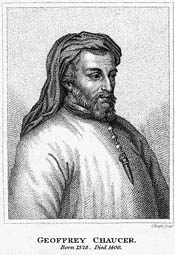









|
III. Geoffrey Chaucer (1340-1400)
1. Life
 Geoffrey Chaucer was the preeminent English poet before William Shakespeare,
and he still retains the position as the most significant poet to write in
Middle English. Chaucer was born of a wine merchant’s family in the early
1340s.
Geoffrey Chaucer was the preeminent English poet before William Shakespeare,
and he still retains the position as the most significant poet to write in
Middle English. Chaucer was born of a wine merchant’s family in the early
1340s.
In Chaucer’s lifetime, he served in a great variety of
occupations. Chaucer first appears in public records in 1357 as a member of
the house of Elizabeth, Countess of Ulster. Two years later Chaucer served
in the army under Edward II and was captured during an unsuccessful
offensive at Reims, although he was later ransomed. Chaucer served under a
number of diplomatic missions. In 1366 Chaucer was married to Philippa Pan,
who had been in service with the Countess of Ulster. Chaucer married well
for his position, for Philippa Chaucer received an annuity from the queen
consort of Edward II. Chaucer himself secured an annuity as yeoman of the
king and was listed as one of the king’s esquires. In 1376, Chaucer entered
the service of King Edward Ⅲ. During the years 1370 to 1378, Chaucer was
frequently employed on diplomatic missions to the Continent, traveling to
Italy for negotiations to open a Genoa port to Britain as well as military
negotiations with Milan. In 1374 Chaucer was appointed comptroller of the
customs and subsidy of wool, skins, and tanned hides for the Port of London.
In October 1385, he was appointed a justice of the peace for Kent, and in
August 1386 he became knight of the shire for Kent. Around the time of his
wife’s death in 1387, Chaucer moved to Greenwich and later to Kent. Changing
political circumstances eventually led to Chaucer falling out of favor with
the royal court and leaving Parliament, but when Richard II became King of
England, Chaucer regained royal favor. From 1389 to 1391, Chaucer served as
a clerk of king’s works. In 1939 Chaucer took the lease of a house in the
garden of Westminster Abbey and soon died afterwards in 1400. He was the
first poet who was buried in Westminster Abbey in London.
2. Literary career
Chaucer’s literary career can be divided roughly into
three periods. The first period stretches from the 1360s to about 1372.
During this time he fell mainly under the influence of French poetry of the
Middle Ages. The second period extends from 1372 to 1385-6. During this
period, the poet wrote under the influence of the great literary geniuses of
the early Renaissance Italy: Dante and Petrarch and Boccaccio. The third and
last period covers the last fifteen years of the poet’s life (1386-1400).
This is a period that Chaucer produced his works of full maturity free from
any dominant foreign influence.
During the first period, Chaucer began his early work
following the French models. The Book of the Duchess, an allegorical
lament written in 1369 on the death of Blanche, wife of John of Gaunt, and a
partial translation of the Roman de la Rose are the representatives.
Chaucer's second period is usually called his Italian period.
During this time his works were modeled primarily on Dante and Boccaccio.
Major works of the second period include The House of Fame,
recounting the adventures of Aeneas after the fall of Troy; The
Parliament of Fowls, which tells of the mating of fowls on St.
Valentine’s Day and is thought to celebrate the betrothal of Richard II to
Anne of Bohemia; and a prose translation of Boethius’ De consolatione
philosophiae.
Also among the works of this period are the unfinished
Legend of Good Women, a poem telling of nine classical heroines,
which introduced the heroic couplet (two rhyming lines of iambic pentameter)
into English verse; the prose fragment The Treatise on the Astrolabe,
written for his son Lewis; and Troilus and Criseyde, based on
Boccaccio’s Filostrato, one of the great love poems in the English language.
In Troilus and Criseyde, Chaucer perfected the seven-line stanza
later called rhyme royal.
To Chaucer's final period, in which he achieved his
fullest artistic power, belongs his masterpiece, The Canterbury Tales.
This unfinished poem, about 17,000 lines, is one of the most brilliant works
in all literature. The poem introduces a group of pilgrims journeying from
London to the shrine of St. Thomas Becket at Canterbury. To help pass the
time they decide to tell stories. Together, the pilgrims represent a wide
cross section of the 14th century English life.

|
![]()
![]()